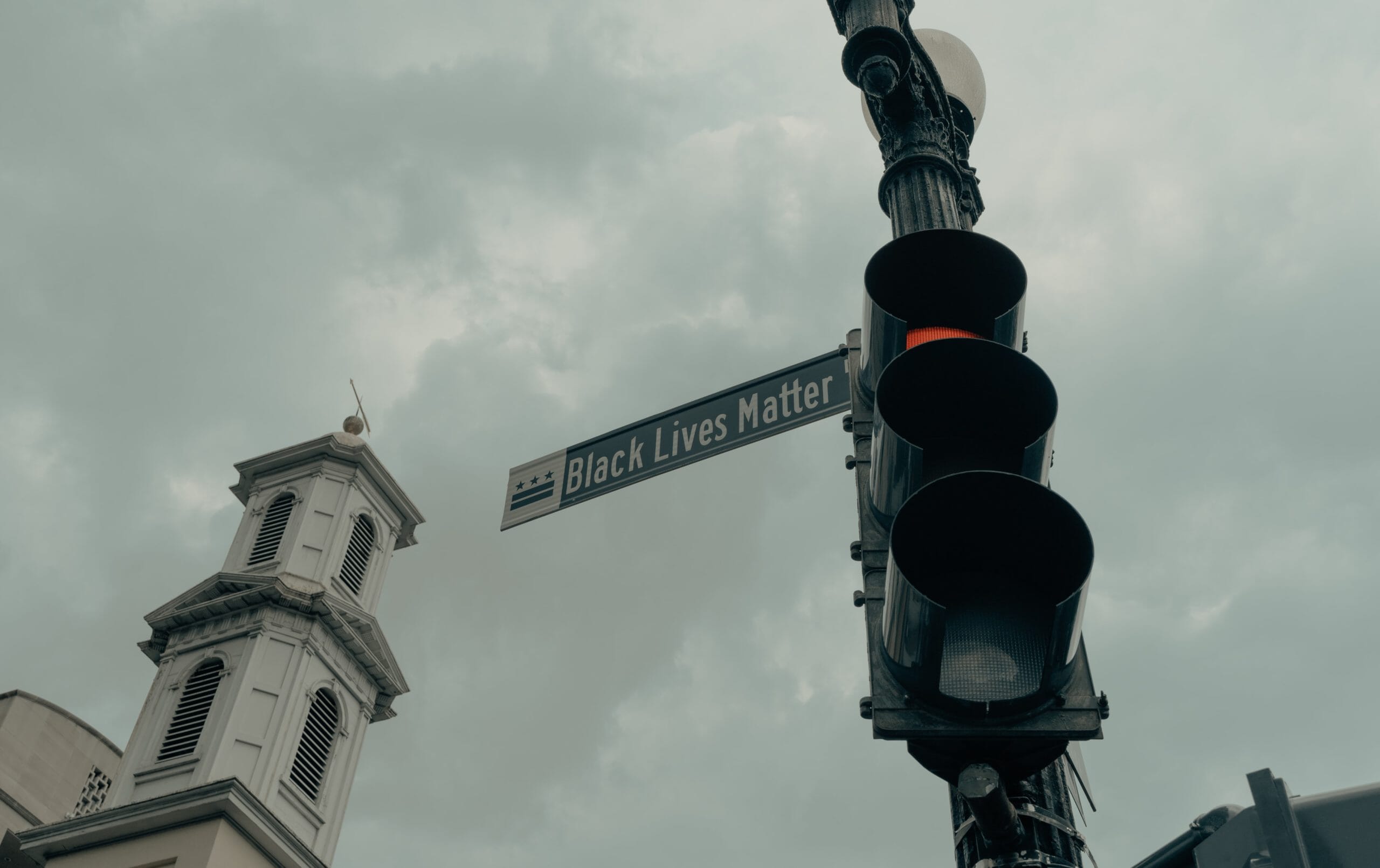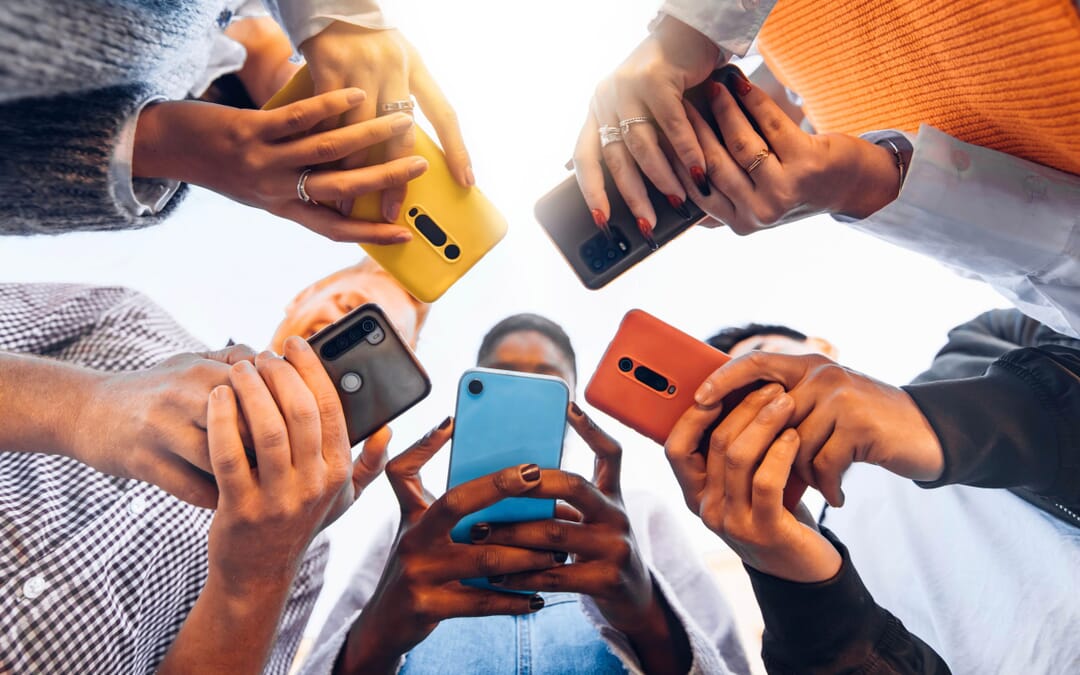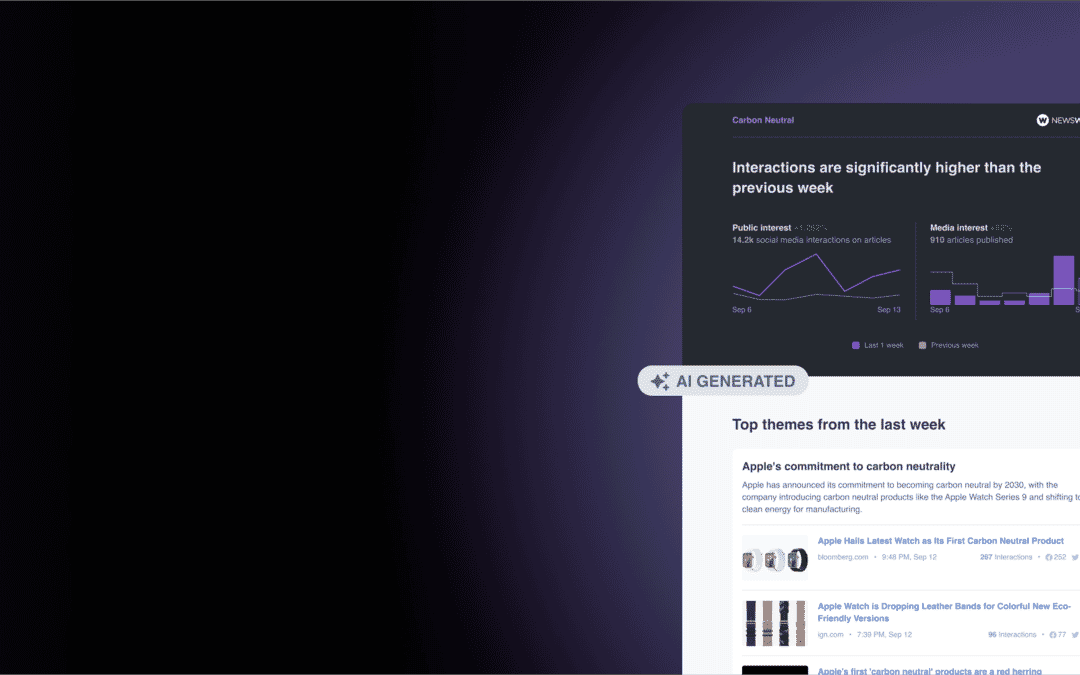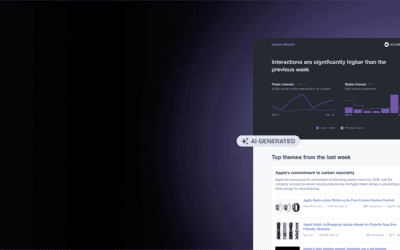It’s been just over three weeks since the killing of George Floyd in police custody in Minneapolis sparked huge waves of Black Lives Matter protests across the US and around the world.
On social media, these protests immediately pulled the nation’s attention away from coverage of coronavirus, which had previously dominated news coverage since March. News stories about the protests have attracted more than a billion engagements since May 17, with daily highs of more than 120 million shares, likes, and comments.
In this piece, we want to explore the narratives and moments that have driven – and continue to drive – massive public engagement with this ongoing story.
Coverage of BLM protests over time
George Floyd was killed in police custody on May 25 after a Minneapolis police officer pinned his neck with his knee for more than eight minutes.
The media picked up on the story the following day, and engagement began to rise around the same time. Protests erupted almost immediately as people took to the streets to call for the firing and arrest of the officers involved.
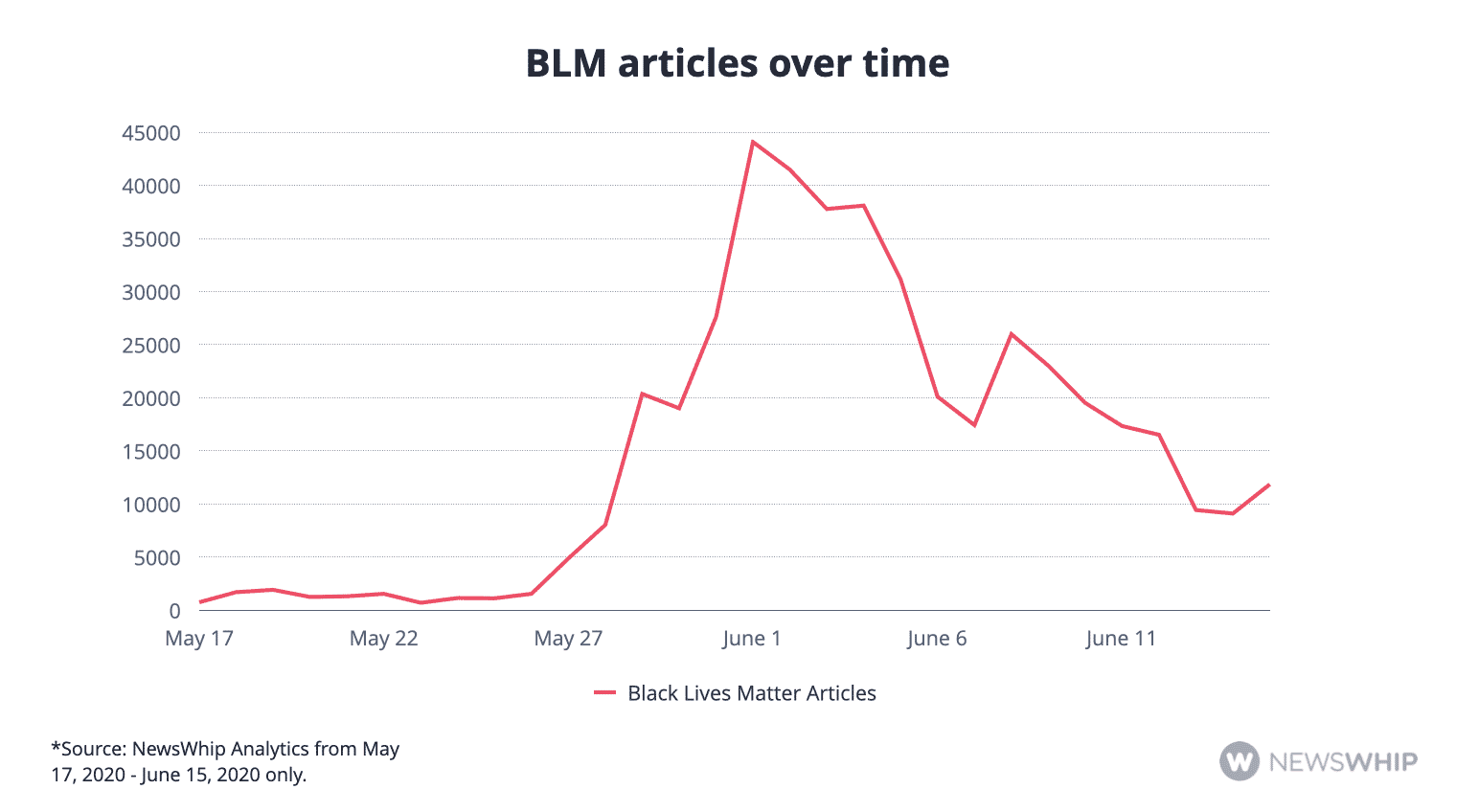
Coverage of and attention to the protests rose rapidly as they spread across the US and beyond, with a peak reaching more than 120 million engagements on June 1. The total amount of engagements around the topic of the Black Lives Matter protests and related keywords for the period we examined (May 17- June 15) was more than a billion.
Early engagements came to pieces calling for justice, with many, including the Minneapolis mayor Jacob Frey and George Floyd’s sister Bridgett, calling for the police officers to be charged.
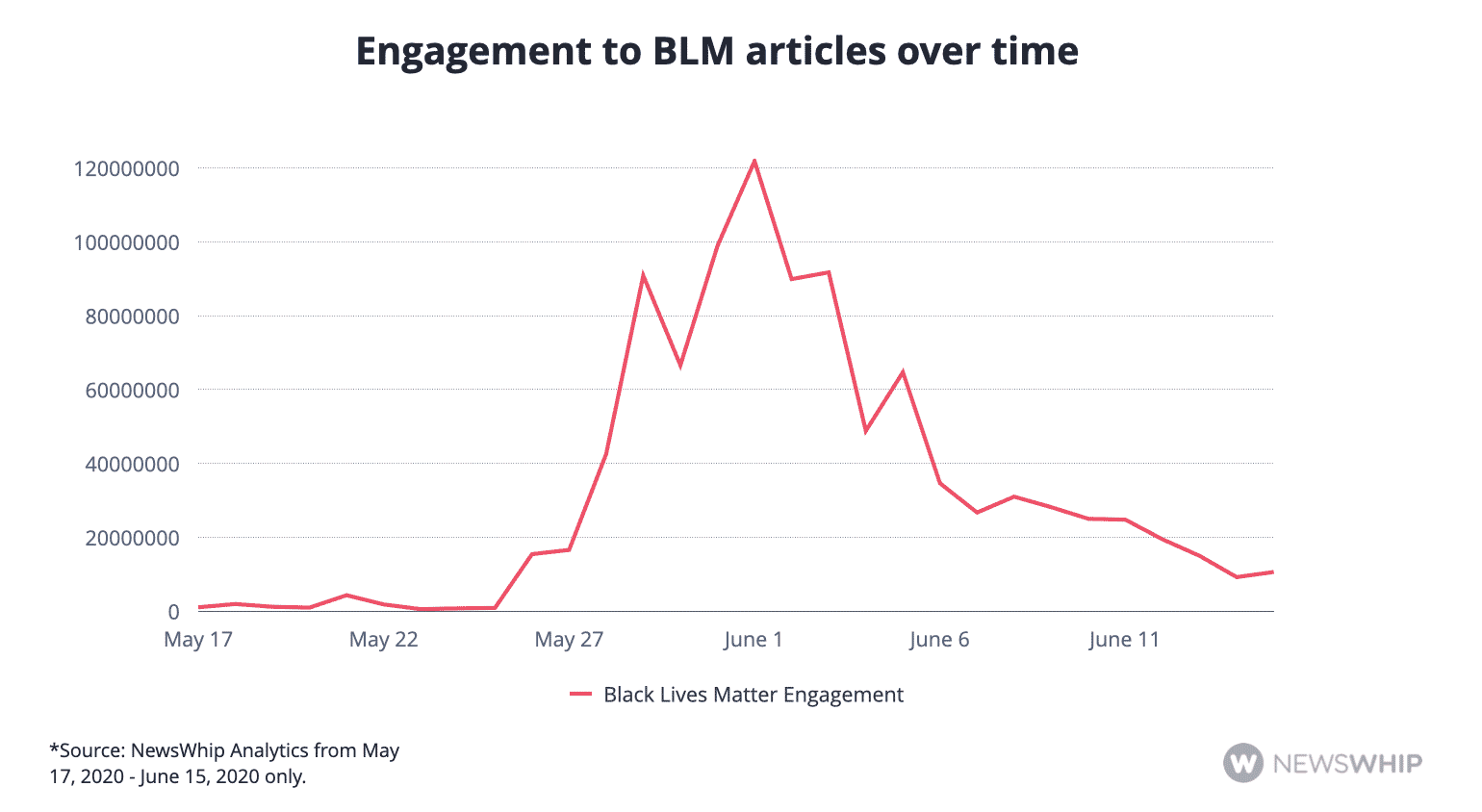
As the protests multiplied and spread beyond Minneapolis, the narrative evolved. An early peak came on May 29, when a CNN crew on the ground in Minnesota was arrested live on television. This news received some 3.9 million engagements.
A secondary, higher peak occurred on May 31 and June 1, as protests continued nationwide. Some of the highest engagement to news coverage came when protestors were joined by police officers, as reported in Forbes and CNN.
Slate was also extremely critical at this time of the way police were managing the protests, in a piece that received more than a million engagements.
June 1 engagements were driven by calls from George Floyd’s brother to end violence at the protests, and with a ruling from an autopsy that Floyd’s cause of death was ‘homicide by asphyxia’.
After June 1, the conversation began to turn more towards societal improvements. Activists made demands and companies scrambled to respond and showcase diversity efforts. We’ll come to this later in the piece, but first wanted to look at which publishers and articles were driving this extremely high level of engagement with the protest movement for the past few weeks.
Top publishers about Black Lives Matter
The most engaged publisher writing about Black Lives Matter since George Floyd’s death has been NBC and its local affiliates, by a considerable distance. With 70 million engagements to their content, they saw almost double the level of interaction as any other publisher. 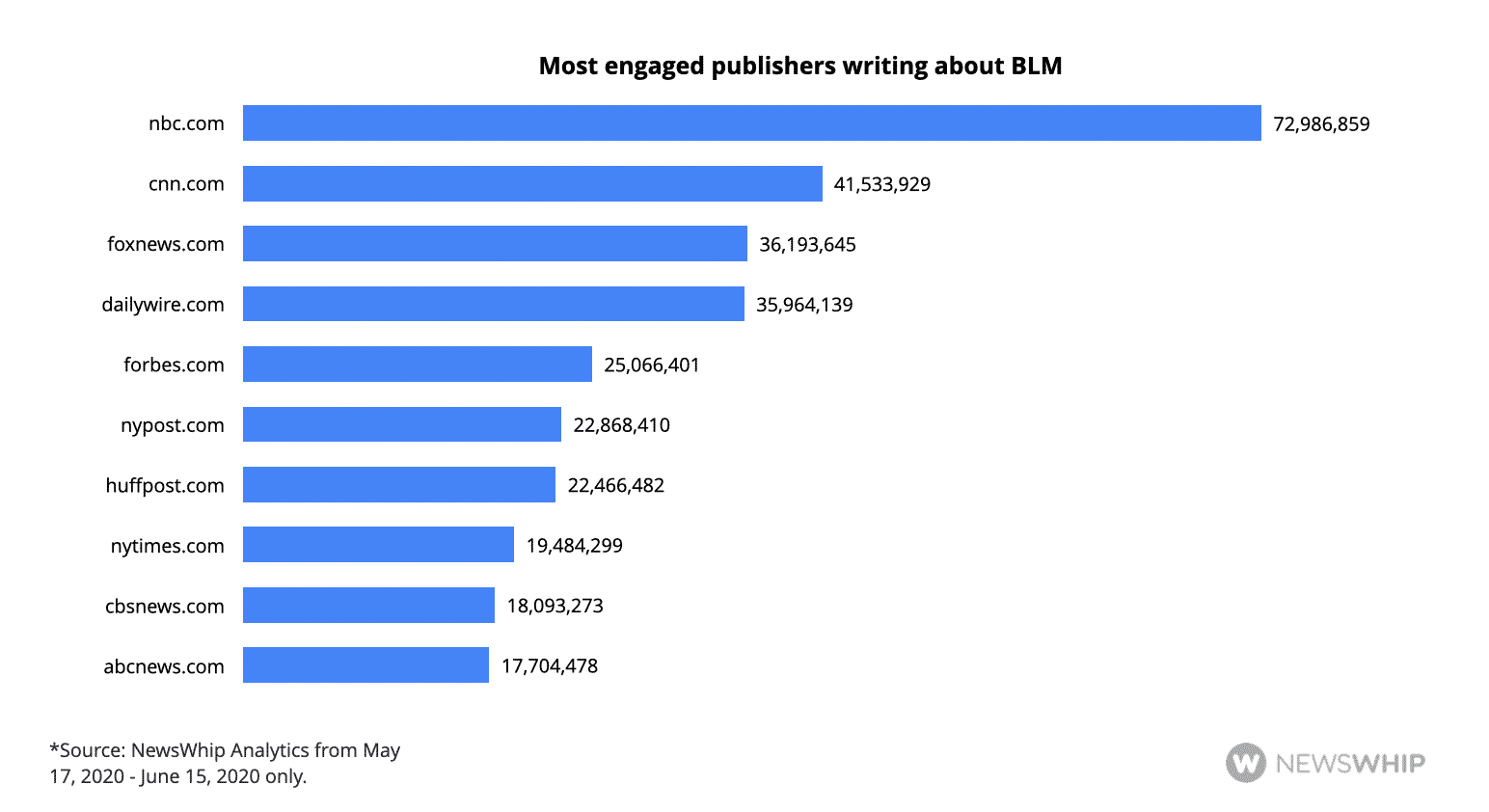
Their top article of the period was about the D.C. mayor ordering a huge Black Lives Matter banner to be painted on the street leading up to the White House, where people had gathered to protest.
The second most engaged publisher was CNN with 41 million engagements. In third and fourth were the more conservative perspectives of Fox News and The Daily Wire, who garnered around 35 million engagements apiece.
Local publishers did play a significant role in some of the coverage, with 25 of the top 250 stories about the protests coming from local outlets, though none of these drove enough interaction to be among the very most engaged publishers.
We have already gone through some of the reporting timeline, but what have been the top articles of the whole period?
The top articles about Black Lives Matter protests
The top story of the whole period was the Forbes article that we mentioned before about police officers joining protesters in marching or taking a knee. This received an unprecedented 15 million engagements, more than any single story we have seen this year within the first month of its publication. This remarkable engagement came from organic sharing by individuals, rather than amplification by influencers, suggesting a genuine mass appeal to this story.

Thematically among the top stories this appeared twice, while calls to minimize violence from George Floyd’s family also appeared twice.
The arrest of the CNN crew made the top ten too, as did the news that the three police officers who watched as the other officer pressed his knee into Floyd’s neck had been charged. This report also confirmed that the other officer’s murder charge had been upgraded from third degree to second degree.
President Trump’s response to the crisis also made the news, featuring twice in the top ten. The first was tangentially with his former Secretary of Defense Jim Mattis publicly denouncing Trump’s actions, in particular the violent clearing of peaceful protestors opposite the White House so that the president could take a photo with a bible outside the church there.
The second time Trump featured was after the more optimistic May jobs numbers were announced, and the president made the reference to Floyd ‘looking down’ and seeing the job numbers as ‘a great day for him’.
Activists demands and notable responses
While it’s useful to see the most engaged reporting to measure the public reaction to the huge social movement, it’s also important to examine what tangible changes have been achieved. To do that we can look at coverage of activists and activism, and at the demands that are making it into major newspapers and cable networks. We can then focus on the tangible changes made by companies and political actions taken as a result of the protests, and the coverage around those steps that have been taken.
There have been wide calls to reform the police, and from some to even defund or disband the police entirely. Minneapolis vowed to disband its police department with a veto-proof majority (783.2k engagements), while op-eds on the matter were published in The Washington Post and The New York Times, with each receiving more than a quarter of a million engagements. The idea was met with significant pushback among conservative media, with The Daily Wire writing about celebrities who supported the call (470.8k engagements), and President Trump immediately dismissed the very idea (709.6k engagements). An impromptu poll of truckers also found that many said they would refuse to deliver loads to cities with defunded police departments (3.7 million engagements).
While cities outside of Minneapolis do not seem in any rush to take similar actions, there have been tangible steps taken in other cities to reform practices that have led to police killing people. Louisville has introduced Breonna’s law, banning the use of no-knock warrants. This was named for Breonna Taylor, who was killed in a shootout in her apartment after such a warrant was executed. This news received almost 2 million engagements.
Democrats also worked on sweeping police reform bills in congress, while former President Obama called for further reform and for protesters to make people in power uncomfortable. New York banned chokeholds and repealed a measure known as 50-A, which shields police disciplinary measures from public view.
Some companies have also seized the moment for some self-reflection. The most impactful of these was Ben & Jerry’s, whose statement on their website received more than a million engagements. They said that ongoing police brutality was “perpetuated by a culture of white supremacy”. The statement ended with calls for three concrete reforms to improve the situation and begin to mend, stating that “Unless and until white America is willing to collectively acknowledge its privilege, take responsibility for its past and the impact it has on the present, and commit to creating a future steeped in justice, the list of names that George Floyd has been added to will never end. We have to use this moment to accelerate our nation’s long journey towards justice and a more perfect union.”
This was a powerful statement from the ice cream brand that resonated with people. Social justice issues are something that the brand has been passionate about for years, so it has built trust with its audience and is part of the conversation. Other brands have been criticized as they have been seen by some to be rushing to jump on a bandwagon, or having their words not match their actions.
This shows the crucial importance of building a reputation if you are going to take a stand on an issue, as Ben & Jerry’s has done over the years.
In sum, these protests have received a huge amount of attention and have already begun to reshape policies in law enforcement and corporate circles. While several tangible steps have been taken in response to the Black Lives Matter movement, activists still say there is a long way to go. Time will tell how these initiatives actually have an impact on a societal level and how conversations about race continue to evolve.
If you want to stay up to date with stories like this in the future, you can sign up for our newsletters here.





